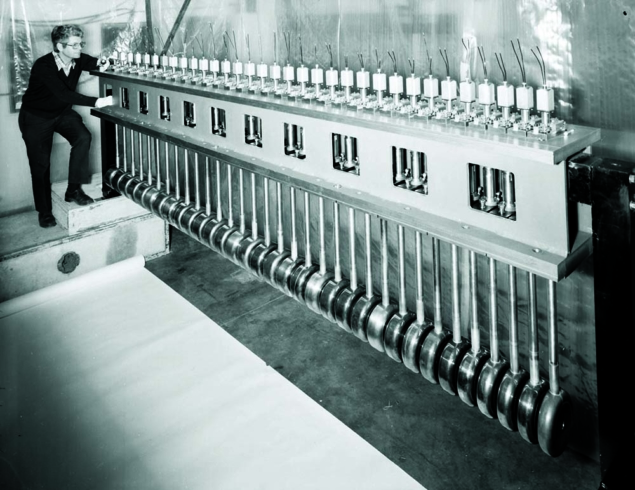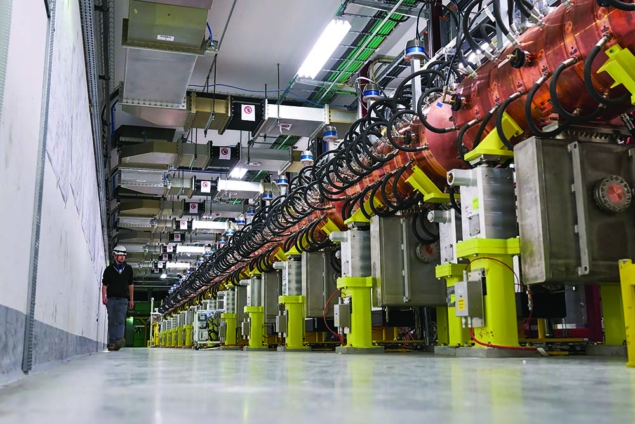Linac2, the machine that feeds CERN’s accelerator complex with protons,
has entered a well-deserved retirement after 40 years of service.

Before being smashed into matter at high energies to study nature’s basic laws, protons at CERN begin their journey rather uneventfully, in a bottle of hydrogen gas. The protons are separated by injecting the gas into the cylinder of an ion source and making an electrical discharge, after which they enter what has become the workhorse of CERN’s proton production for the past 40 years: a 36 m-long linear accelerator called Linac2. Here, the protons are accelerated to an energy of 50 MeV, reaching approximately one-third of the speed of light, ready to be injected into the first of CERN’s circular machines: the Proton Synchrotron Booster (PSB), followed by the Proton Synchrotron (PS) and the Super Proton Synchrotron (SPS). At each stage of the chain, they may end up driving fixed-target experiments, generating exotic beams in the ISOLDE facility, or being injected into the Large Hadron Collider (LHC) to be accelerated to the highest energies.
Situated at ground level on the main CERN site, Linac2 has delivered all of the protons for the CERN accelerator complex since 1978. Construction of Linac2 started in December 1973, and the first 50 MeV beam was obtained on 6 September 1978. Within a month, the design current of 150 mA was reached and the first injection tests in the PSB started. Routine operation of the PSB started soon afterwards, in December 1978. As proudly announced by CERN at the time, Linac2 was completed on budget and on schedule, for an overall cost of 23 million Swiss francs.
Linac2 is the machine that started more than a billion-trillion protons on trajectories that led to discoveries including the W and Z bosons, the creation of antihydrogen and the completion of the long search for the Higgs boson. On 12 November, Linac2 was switched off and will now be decommissioned as part of a major upgrade to the laboratory’s accelerator complex (CERN Courier October 2017 p32). Its design, operation and performance have been key factors in the success of CERN’s scientific programme and paved the way to its successor, Linac4, which will take over the task of producing CERN’s protons from 2020.
The decision to build Linac2 was taken in October 1973, with the aim to provide a higher-intensity proton beam compared to the existing Linac1 machine. Linac1 had been the original injector both to the PS when it began service in 1959, and to its booster (the PSB) when it was added to the chain in 1972. However, Linac1 was limited in the intensity it could provide, and the only way to higher intensity was for an entirely new construction.
Forward thinking
Linac2’s design parameters were chosen to comfortably exceed the nominal PSB requirements, providing a safety margin during operation and for future upgrades. Furthermore, it was decided to install the linac in a new building parallel to the Linac1 location instead of in the Linac1 tunnel. This avoided a long shut-down for installation and commissioning, and ensured that Linac1 was available as a back-up during the first years of Linac2 operation.
Linac2’s proton source was originally a huge 750 kV Cockcroft–Walton generator located in a shielded room, separate from the accelerator hall (figure 1), which provided the pre-acceleration to the entrance of the 4 m-long low energy beam transport line (LEBT). This transport line included a bunching system made of three RF cavities, after which protons were fed to the main accelerator: a drift-tube linac (DTL) that had many improvements with respect to the Linac1 design and became a standard for linacs at the time. The three accelerating RF “tanks”, increasing the beam energy up to 10.3, 30.5 and 50 MeV, respectively, with a total length of 33.3 m, were made of mild steel co-laminated with a copper sheet, with the vacuum and RF sealing provided by aluminium wire joints.
The RF system is of prime importance for the performance of linear accelerators. For Linac2, the amplifiers had to provide a total RF power of 7.5 MW just to accelerate the beam. The RF amplifiers were based on the Linac1 design principles, with larger diameters in order to safely deliver the higher power, and the RF tube was the same triode already used for most of the Linac 1 amplifiers.

The most significant upgrade to Linac2, which took place during the 1992/1993 shutdown, was the replacement of the 750 kV Cockcroft–Walton generator and of the LEBT with a new RF quadrupole (RFQ) only 1.8 m long, capable of bunching, focusing and accelerating the beam in the same RF structure. The RFQ was a new invention of the early 1980s that was immediately adopted at CERN: after the successful construction of a prototype RFQ for Linac1 (which at the time was still in service), the development of a record-breaking high-intensity RFQ for Linac2, capable of delivering to the DTL a current of 200 mA, started in 1984. The prototype high-current RFQ was commissioned on a test stand in 1989, and the replacement of the Linac2 pre-injector was officially approved in 1990.
Gearing up for the LHC
The main motivation for the higher current of Linac2 was to prepare the CERN injectors for the LHC, which was already in progress. It was clear that the LHC would require unprecedented beam brightness (intensity per emittance) from the injector chain, and one of the options considered was to go to single-turn injection into the PSB of a high-current linac beam to minimise emittance growth. This, in turn, required the highest achievable current from the linac. Another motivation for the replacement was the simpler operation and maintenance of the smaller RFQ compared with the large Cockcroft–Walton installation.

Construction of the new RFQ (figure 2) started soon after approval, and the new “RFQ2” system was installed at Linac2 during the normal shut-down in 1992/1993. Commissioning of the RFQ2 with Linac2 took a few weeks, and the 1993 physics run started with the new injector. Reaching the full design performance of the RFQ took a few years, mainly due to the slow cleaning of the surfaces that at first limited the peak RF fields possible inside the cavity. After the optics in the long transfer line were modified, the goal of 180 mA delivered to the PSB was achieved in 1998 – and this still ranks as the highest intensity proton beam ever achieved from a linac.

Throughout its life, Linac2 has undergone many upgrades to its subsystems, including major renovations of the control systems in 1993 and 2012, the exchange of more than half its magnet power supplies to more modern units (although a large number were still the same ones installed in the 1970s) and renovation of the RFQ and vacuum-control systems. Nevertheless, at its core, the three DTL RF cavities that are the backbone of the linac remained unchanged since their construction, as were more than 120 electromagnetic quadrupoles sealed in the drift tubes that have each pulsed more than 700 million times without a single magnet failure (figure 3).

Despite the performance and reliability of Linac2, the performance bottleneck of the injection chain for the LHC moved to the injection process of the PSB, which could only be resolved with a higher injection energy. This meant increasing the energy of the linac. At the time this was being considered, around a decade ago, Linac2 was already reaching 30 years of operation, and basing a new injector on it would have required a major consolidation effort. So the decision was made to move to a new accelerator called Linac4 (the name Linac3 is taken by an existing CERN linac that produces ions), which meant a clean slate for its design. Linac4 (figure 4) not only injects into the PSB at the higher energy of 160 MeV, but also switches to negative hydrogen-ion beam acceleration, which allows higher intensities to be accumulated in the PSB after removing the excess electrons.
As was the case when Linac2 took over from Linac1, Linac4 has been built in its own tunnel, allowing construction and commissioning to take place in parallel to the operation of Linac2 for the LHC (CERN Courier January/February 2018 p19). In connecting Linac4 to the PSB, some of the Linac2 transfer line will be dismantled to make space for additional shielding. But the original source, RFQ and three DTL cavities will remain in place for now – even if there is no possibility of their serving as a back-up once the change to Linac4 is made. As for the future of Linac2, hopefully you might one day be able to find part of the accelerator on display somewhere on the CERN site, so that its place in history is not forgotten.





